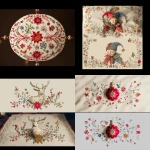Explore the Best AI Image Gallery

Revolutionizing Smart Homes: The Impact of IoT on Creative Living Spaces
The Internet of Things (IoT) has ushered in a new era of technological integration in our daily lives. Among its most significant applications is the realm of smart homes, where connectivity and automation combine to enhance comfort, efficiency, and creativity. In this blog post, we will explore the various aspects of IoT in smart homes, considering its potential uses, impact on the creative industry, ethical considerations, and future trends.
The Transformative Potential of IoT in Smart Homes
IoT technology enables a vast network of devices to communicate and collaborate, creating seamless interactions between appliances, systems, and users. Imagine a home that learns your preferences and adjusts heating, lighting, and ambiance accordingly. Enhanced convenience isn't merely a luxury anymore; it has become an expectation. As IoT devices proliferate, so do their capabilities, leading to smart features like automated window blinds, smart refrigerators, and voice-activated lighting systems. These technologies work together not just to provide comfort but also to serve as a backdrop for creativity. Artists, designers, and creators are using IoT to integrate technology into their workflows in innovative ways. For instance, a connected workspace can tailor environmental conditions to optimize creative processes, whether it's adjusting the lighting for better visibility or controlling the temperature to preserve materials.
Impact on the Creative Industry
IoT can greatly facilitate the creative industry, providing new tools for artistic expression, collaboration, and engagement with audiences. Here are some compelling examples of how IoT intersects with creativity in smart homes:
- Interactive Art Installations: Artists are increasingly using IoT-connected devices to create interactive art that responds to viewers, offering a deeper level of engagement. These installations can change in real-time based on audience reactions or environmental conditions.
- Smart Home Studios: Creatives can set up studios equipped with IoT devices that enhance the production process, allowing for automated scheduling, lighting adjustments, and even soundproofing features.
- Enhanced Storytelling: Through IoT, narratives can become immersive experiences. For example, QR codes connected to smart devices can lead audiences on a narrative journey throughout a smart home, blending the physical and digital worlds.
Ethical Considerations
Despite the benefits, the integration of IoT into smart homes raises ethical concerns. As homes become increasingly connected, issues surrounding data privacy and security emerge. Smart devices often collect data on user habits, preferences, and even sensitive information. It's crucial for consumers and developers alike to be aware of how this information is stored, used, and protected. Furthermore, the potential for surveillance is heightened in environments rich with IoT devices. Homeowners must consider the implications of having their living spaces constantly monitored and ensure they are safeguarding their privacy. Solutions include opting for devices with strong encryption and regularly updating security measures.
Future Trends in IoT and Smart Homes
The future of IoT in smart homes holds a myriad of possibilities that can push the boundaries of creativity and functionality. Here are several trends anticipated in the coming years:
- Increased Personalization: As machine learning algorithms improve, smart homes will be able to cater to individual preferences to an unprecedented degree. This level of personalization can not only improve comfort but also enhance creative expression.
- Integration of AI: Artificial Intelligence (AI) will play a pivotal role in analyzing data gathered from IoT devices, enabling predictive adjustments and automated creative workflows.
- Sustainability Focus: Future innovations in IoT will increasingly address sustainability, helping homeowners manage energy consumption and reduce waste. This focus can inspire creativity in eco-friendly design and sustainable living practices.
The intertwining of IoT and smart homes is reshaping how we live, create, and interact with our environments. As we continue to explore these technologies, it's crucial to balance the benefits they provide with a conscientious approach to ethical considerations and data privacy. The landscape of creativity is expanding, and as smart homes evolve, they promise to serve not only as sanctuaries of comfort but also as inspiring spaces for artists and creators alike.



](https://images.ai-img.art/thumbnails/150/e6a179db327f0374ec327d0fdab48ac1f2dc47123eed103b0a41ed346280d07d.webp)









](https://images.ai-img.art/thumbnails/150/6c909fd6d38caac6572b592dd97831deb7d6562bba142798574677582676dfc1.webp)






](https://images.ai-img.art/thumbnails/150/655229c40961cb7ff5abd4b4190e02c94ea1a961106e7547a562649c945268be.webp)
](https://images.ai-img.art/thumbnails/150/184b4b030e30be0a6d51b544226cb4cf2271977814d935d3aaa2b7529355b3b7.webp)



](https://images.ai-img.art/thumbnails/150/1202074d0d60b08b64d0f91f36468608aaac200a02b721cc8e6d8ec8a908432c.webp)





](https://images.ai-img.art/thumbnails/150/26c16e4f635deee86633de398088ca98d9bb748d6e7601436b07e882fab236cb.webp)












](https://images.ai-img.art/thumbnails/150/60973df1d727dbbf8e6922b7e4836814ab6012106eb9dcfe99aea7aec15f3710.webp)




